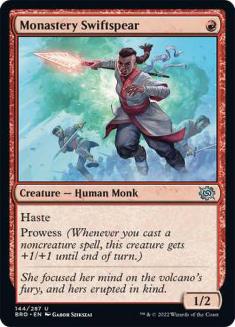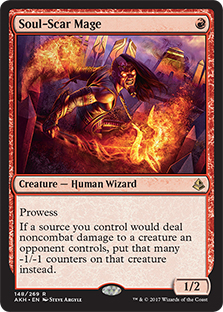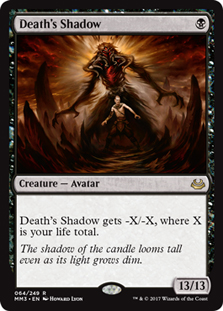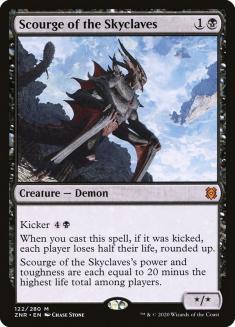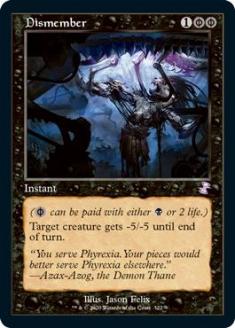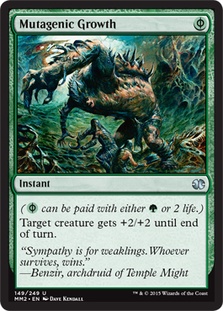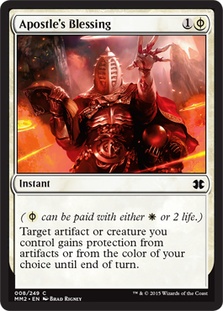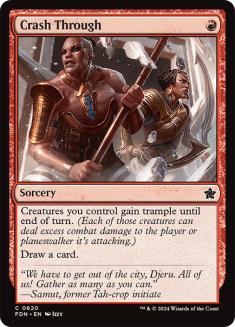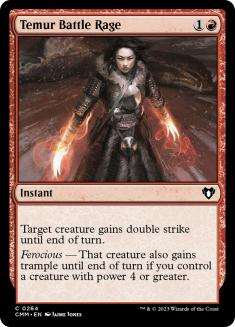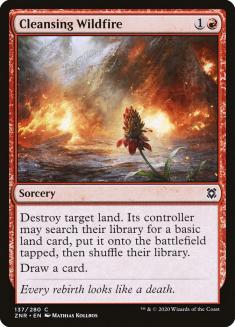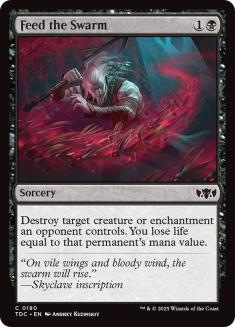Grixis Death’s Shadow was a wonderful, fun, exciting, multi-layered archetype that brought me a ton of joy for over a year as I tweaked it and made it work through various different incarnations of the Modern format. The fact that it could play as aggressively as an Infect deck or as patiently as a ponderous Grixis Control deck entranced me. The way that it retained near-perfect information through copious use of discard spells made it the perfect tool for an experienced player. And of course, the fact that it got to play Snapcaster Mage, my favorite card of all time, meant that there was always a line of reasoning, no matter how convoluted, that led to me sleeving it up in a variety of environments.
Sadly, Magic has been on an exceptionally wild ride since the release of War of the Spark, with power creep posing a serious problem and leading to volatility and instability in the various Constructed formats. One victim of this instability was Grixis Death’s Shadow, which became alternately unplayable and broken, depending on which busted card was legal at that time. Mox Opal; Oko, Thief of Crowns; and Mycosynth Lattice were all banned, which immediately made Grixis Death’s Shadow strong again. Then, while Lurrus of the Dream-Den made Death’s Shadow incredible, after the rule change to Companion suddenly Grixis Death’s Shadow wasn’t all that anymore. Arcum’s Astrolabe and Once Upon a Time also got banned to reduce competition for Death’s Shadow, but Uro, Titan of Nature’s Wrath also cut away at Shadow as a hard-to-stop end-game that allowed the midrange multicolor Uro decks to boast a strong matchup. It’s been such a wild year, it’s become hard to predict what will be good in Modern even a few months into the future.
Modern has long been a format where players felt comfortable investing in a deck or two that they could reliably play for years. That paradigm has been thrown out the window, but in its wake, we have a more dynamic and exploitable format. With the release of Zendikar Rising, that volatility has shifted the playing field back in favor of Death’s Shadow, this time in a powerful and resilient blend with the prowess pair, Soul-Scar Mage and Monastery Swiftspear.
Really, it’s about time. The pairing of one- and zero-mana spells with cheap oversized threats is going to allow this deck to finally hope to slip under the Uro midrange piles, while the presence of Lurrus and a few recursive cards out of the sideboard means that it will be hard to outgrind this beast.
A deck with an ultra-low average converted mana cost, a near-inability to get mana flooded, and a grindy sideboard plan? This sounds like the recipe for a new interactive deck to take over Modern! The list, surprisingly, is very stock at this point, with few deviations from the following:
Creatures (16)
Lands (17)
Spells (27)

Some folks prefer a slightly different mix of removal spells in the maindeck, or a few changes here and there to the sideboard, but the core of the deck is about as universal as it gets:
4 Monastery Swiftspear and 4 Soul-Scar Mage
This is your prowess package. These creatures are among the strongest in Modern, and for good reason. It’s quite easy for a one-mana investment on the first or second turn to pay off in the middle turns with a 6/7 or larger creature that pummels the opponent out of nowhere. A simple Mutagenic Growth, a Lava Dart (and its associated flashback), and you’re in business! Throw in a Crash Through or a Temur Battle Rage and the game ends on the spot.
These creatures belong to a unique class of cards: they get better the more strong cards of another category are printed. Just like how Birthing Pod could only ever get stronger the more powerful creatures with good enters-the-battlefield abilities saw print, these particular one-mana creatures get better and better with every strong zero- and one-mana spell printed. It’s part of the reason that Modern nowadays has a red-based Prowess deck near the top of the metagame no matter what. Going forward, it’s not insane to think that these creatures will remain ubiquitous in the format.
Blending them with a new pair of creatures, though, hasn’t been a big part of Modern until now:
4 Death’s Shadow and 4 Scourge of the Skyclaves
This is your “creatures that benefit from life loss” package. Scourge of the Skyclaves can frequently be a 10/10 or larger for a mere two mana, and we are all familiar with Death’s Shadow by now.
Ari Lax, just this past week, went over some of the non-intuitive plays that come up with Scourge of the Skyclaves in particular, how it turns Lightning Bolts into six-point Lava Spikes, and how it leverages the chip-shot damage from your small prowess creatures to become a one-turn lethal threat on its own.
What’s the purpose of these spells? They require you to make some sacrifices, and ride along at a low life total, risking getting defeated in a single shot, but in exchange they offer you oversized creatures for very little mana. This wasn’t always a trade that was considered worth it, but as decks have gotten better at providing cheap ways to pay life and deal damage, this class of cards has suddenly become incredible.
These creatures also have synergy with a particular class of cards, ones that cost life in order to do overpowered or off-color things. The premier example of that? Phyrexian mana, one of the most broken mechanics in Magic’s long history.
Even though Gitaxian Probe and Mental Misstep are long gone from Modern, a few alternatives still exist and provide this ostensibly two-color deck with effects it should really never be permitted to use.
2 Dismember, 2 Mutagenic Growth, and 2 Apostle’s Blessing
Phyrexian mana is absolutely unfair, and it’s not surprising that it has a front-and-center spot in this deck. These instants trigger prowess on the cheap and boost Death’s Shadow simply by being cast. Dismember in particular is often one of the components of the best Death’s Shadow starts, and leads to the dreaded third-turn kills with stunning regularity.
For example, a Monastery Swiftspear off a fetchland into a Blood Crypt on Turn 1; followed by another fetchland, another Blood Crypt, a Dismember, and a 3/3 Death’s Shadow on Turn 2; followed by another fetchland into another Blood Crypt, a Mutagenic Growth, an Apostle’s Blessing, a Lava Dart, and the flashback on Turn 3 is more than enough to add up to twenty damage without even getting a Temur Battle Rage involved! Dismember allows for the deployment of frighteningly large Death’s Shadows as early as Turn 2.
Protection spells and pump spells are almost universally green and white effects, but somehow both have found their way into a Rakdos deck. Even better, they’re now undercosted and cost life, both benefits in this deck! It’s not surprising that they have kicked up both the prowess and the life-loss creature packages into the stratosphere with their power and synergy.
2 Crash Through, 2 Temur Battle Rage
Temur Battle Rage has been a staple of Death’s Shadow decks for as long as they’ve existed. It lets you steal games out of nowhere, winning at low life totals in the face of impossible-looking battlefields.
Crash Through has been an occasional inclusion in Prowess decks, offering a way for them to push damage through blockers on their “combo” turns, which can see the prowess creatures get up to a disgusting eight or more power. At a mere one mana, and with a cantrip effect to boot, Crash Through is just enough of a blend of a bad Temur Battle Rage and a bad Mishra’s Bauble to merit an inclusion here. If you have a battlefield of multiple prowess creatures and need to push through a win, Crash Through can be even better than Temur Battle Rage. Of course, if you have a small battlefield and simply want to churn through your deck for more gas, Crash Through does that as well.
Ari Lax also discussed in his article the funny way that Temur Battle Rage works differently in a Prowess deck than you may be used to in traditional Grixis Death’s Shadow. Not only does it more frequently get cast here as a “turn-before-alpha-strike chip-shot,” but something very interesting happens when you cast it on a Scourge of the Skyclaves. Double strike means that the Scourge powers up mid-combat. If you’re at ten life, then a Scourge of the Skyclaves that looks unassuming at 2/2 can turn lethal with a single Lightning Bolt and a Temur Battle Rage. The Lightning Bolt takes the opponent from eighteen to fifteen and makes the Scourge a 5/5. Then the Temur Battle Rage makes Scourge strike once for five and once for ten. That’s the game!
1 Lurrus of the Dream-Den
The companion mechanic may have been neutered after it became clear that it was unfathomably strong, especially with this particular creature, but even when Lurrus of the Dream-Den costs an extra three mana, it’s still well worth inclusion. When you cast a Lurrus of the Dream-Den, it’s almost always immediately preceding a cheap threat right out of the graveyard. Suddenly you’re up at least two cards with the threat of many more in the coming turns.
Lurrus does an incredible job of keeping Rakdos Death’s Shadow from ever getting mana flooded, as you always have uses for an extra six mana to deploy this unique threat. Lurrus even acts as a source of lifegain in a pinch, if you’ve inadvertently dealt yourself too much damage and need to gain some life back! Is there anything it can’t do?
The rest of the deck – the Lightning Bolts, Lava Darts, single Fatal Push, Thoughtseizes, and Mishra’s Baubles – are just generally high-quality spells. They offer creature removal and hand disruption (or in Bauble’s case, a broken effect in the last remaining zero-mana cantrip in Modern).
The manabase is straightforward, with most of the focus involving the many fetchlands, four Blood Crypts, and two basic lands. The spice is in that strange new card from Zendikar Rising, Agadeem’s Awakening. It’s generally just a Swamp that costs three life to play untapped. A three-life Swamp is a bargain in a Death’s Shadow deck, of course, which often wants to deal itself as much damage as possible as quickly as possible. However, the true joy of the card is in the reverse side, which allows you to spend five mana to return a Death’s Shadow and a Scourge of the Skyclaves from the graveyard to the battlefield. Heck, if a Lurrus manages to get into your graveyard, it will bring that monster back, too! I’m frankly surprised that we don’t see a second copy of this card in the deck, as it mitigates both mana flood and mana screw.
The rest of the sideboard is full of the usual fare, with a few Kozilek’s Returns to combat Auriok Champions, a few Fatal Pushes for the mirror match, a couple of Nihil Spellbombs for recursive graveyard hate with Lurrus, a few copies of Kroxa and Kolaghan’s Command to keep grinding in the case where you need to shift gears, and two unique new cards from Zendikar Rising: Cleansing Wildfire and Feed the Swarm.
Feed the Swarm is just a powerful and flexible new inclusion that extends a nearly free-roll enchantment removal effect into black for some reason. The card Vendetta would have been strong in this deck, but Feed the Swarm is similar and now simply allows Rakdos to destroy enchantments. There are a great many times I would have loved to have this card in my Grixis Death’s Shadow decks to combat cards like Rest in Peace or Runed Halo, but I never would have thought it would come in such a straightforward way! I was used to playing with cards like Engineered Explosives to try to awkwardly combat them, but this is quite a refreshing solution.
Of course, I’ve written about Cleansing Wildfire at length before, and I have no doubt that it will remain a notable sideboard player in Modern for many years. It’s not at its best right now, as Mono-Green Tron is not a particularly widely-played deck right now, but I have no doubts that it will come into vogue as a solution when it’s needed. Whether it’s destroying lands out of Belcher or Oops, All Spells with no drawback, or just taking Amulet Titan players back a turn, it’s a key piece of the puzzle for this deck to succeed without countermagic in a format with as many big spells as Modern.
There are a great many public figures in the world of Magic debating reasons not to be excited about the game. Whether they’re talking about problems in Standard, an opaque Organized Play system, or the general despair surrounding COVID-19 and its attendant effect on tabletop events, sometimes it feels like there’s nothing to be excited about in the world of Magic. It’s good to find a new way to enjoy the game even in adverse conditions, and Rakdos Death’s Shadow offers exactly that to long-tenured fans of Death’s Shadow like myself. It’s a refreshing new blend of familiar archetypes, and for the first time in a long time, I’m thrilled to see something new in the world of Magic.
I just can’t wait to play more games with it!


